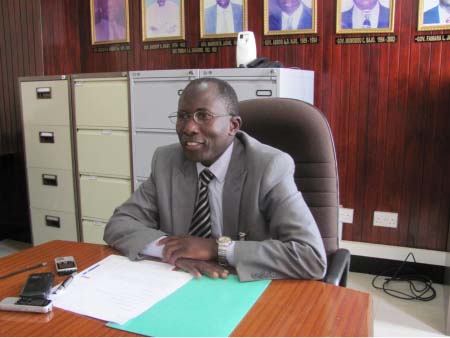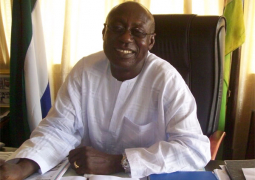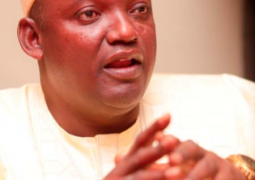
Over the year between 2013 and 2014, a lot of developments have taken place in the Gambian economy which affected the current strength of the Gambian dalasi, consumer price inflation, domestic debt, balance of payments, fiscal operations (that is revenue and expenditure) and the banking sector.
All these put together influenced the decision of the Monetary Policy Committee (MPC) of the Central Bank of The Gambia (CBG) to maintain the policy rate, otherwise known as the interest rate, at 20 per cent for the next three months to come.
In the quarter to end-March 2014, the Dalasi depreciated against the US dollar by 1.9 per cent, Euro 1.2 per cent and the Pound Sterling 3.3 per cent.
For the twelve months to end-March 2014, the Dalasi weakened against the US dollar by 12.0 per cent, Euro 20.9 per cent and Pound Sterling 21.1 per cent.
These data were presented by the Governor of The Central Bank of The Gambia, Hon Amadou Colley, at a press briefing held yesterday at the Board Room of the CBG.
On outlook for inflation, Governor Colley said consumer price inflation, measured by the National Consumer Price Index (NCPI), increased to 5.56 per cent in March 2014, higher than the 5.35 per cent recorded in March 2013.
“Both food and non-food prices accelerated to 6.42 per cent and 4.3 per cent respectively from 4.78 per cent and 4.12 per cent respectively in March 2013,” the governor said, adding that core inflation, which excludes the prices of volatile food items and energy, also rose to 5.56 per cent from 5.29 per cent in March 2013.
For the remainder of the year, inflation is forecast to average 5 per cent. The main upside risk to the forecast continued to come from the exchange rate, which, despite the recent relative stability, remains “vulnerable to domestic and external shocks”.
However, Governor Colley indicated, the tight monetary policy stance and stronger pace of fiscal consolidation might reinforce the anchoring of inflation expectations. “The Committee judges that the risks to the projected inflation path are roughly balanced,” he added.
In the year to end-March 2014, the domestic debt rose to D13.9 billion, or 23.4 per cent from March 2013. The CBG governor said Treasury bills and Sukuk-Al Salaam bills, which accounted for 81.8 per cent and 3.6 per cent of the domestic debt stock, increased by 30.2 per cent and 18.7 per cent respectively.
He stated: “Yields in the money market rose significantly, reflecting in the main the tightening of monetary policy.
“The yield on the 91-day, 182-day and 364-day Treasury bills rose from 9.44 per cent, 9.86 per cent and 10.23 per cent in March 2013 to 15.46 per cent, 16.70 per cent and 18.48 per cent respectively in March 2014.”
The Gambian economy is also estimated to have grown by 5.6 percent in 2013, although lower than the 6.1 per cent growth in 2012.
Economic activity in 2014 is expected to expand to around 6.0 -6.5 per cent on the back of robust growth in tourism and agriculture, said the Central Bank Governor.
The overall balance of payments reduced to a surplus of US$39.7 million in 2013 compared to US$75.12 million in 2012.
The current account recorded a surplus of US$85.54 million, higher than the surplus of US$78.9 million in 2012, whilst the goods account deficit reduced to US$102.9 million compared to the deficit of US$168.3 million in 2012.
Merchandise exports, according to the bank governor, amounted to US$150.4 million, a decline of 11.0 per cent. Imports also decreased but at a stronger pace of 22.0 per cent to US$270.04 million.
The services account surplus rose to US$97.93 million relative to US$75.63 million in 2012, the governor notes, adding that the capital and financial account deficit widened to US$45.84 million compared to the deficit of US$3.78 million in 2012.
Data on government fiscal operations in the first quarter of 2014 indicate that total revenue and grants increased to D2.09 billion, higher than the D1.62 billion in the corresponding quarter of 2013.
“Domestic revenue, comprising tax and non-tax revenue, amounted to D1.57 billion compared to D1.44 billon in the first quarter of 2013,” Hon Colley said. “Tax and non-tax revenue increased by 11.0 per cent and 1.0 per cent respectively.
“Grants also rose to D519.6 million relative to D185.4 million in the first quarter of 2013 attributed mainly to project grants.
On expenditure, the governor stated: “Expenditure and net lending totaled D2.69 billion, higher than the D2.11 billion in the first quarter of 2013.
“Current and capital expenditure rose to D1.88 billion and D813.3 million compared to D1.53 billion and D575.5 million respectively in the corresponding quarter of 2013.
“The overall budget balance (including grants) recorded a deficit of D214.0 million (2.0 per cent of GDP) which was financed solely by domestic borrowing.”
Developments in the monetary sector indicate that broad money grew by 10.4 per cent in the year to end-March 2014 compared to 8.8 per cent a year earlier.
This was mainly attributed to the robust growth in the Net Domestic Assets (NDA) of the banking system to D13.5 billion, or 14.6 per cent, Governor Colley noted.
He added: “The Net Foreign Assets (NFA) of the banking system, on the other hand, contracted slightly to D4.6 billion, or 0.3 per cent.
“Reserve money increased markedly by 30.7 per cent relative to 3.4 per cent a year earlier on the back of the 198.7 per cent increase in the NDA of the Central Bank of The Gambia. In contrast, the NFA declined by 18.4 per cent.”
Volume of transactions in the foreign exchange market, he disclosed, increased to US$363.5 million in the first quarter of 2014, or 7.3 per cent from the previous quarter.
“However, compared to the first quarter of 2013, volumes decreased by 17.4 per cent,” he added.
According to recent data on the banking industry, capital and reserves grew from D2.85 billion in March 2013 to D3.04 billion in March 2014.
The risk-weighted capital adequacy ratio averaged 26.5 per cent, slightly lower than the 27.3 per cent in March 2013.
Total assets rose to D24.60 billion, or 16.4 per cent from a year ago, the MPC report stated, adding that gross loans and advances, accounting for 25.0 per cent of total assets, increased to D6.14 billion, or 6.1 per cent from a year earlier.
Private sector credit, net of provisions, grew by 5.7 per cent compared to 10.2 per cent a year earlier, the report indicated, saying the non-performing loans (NPL) ratio rose to 17.4 per cent, higher than the 11.0 per cent in March 2013.
Deposit liabilities totaled D14.74 billion, an increase of 9.4 per cent from March 2013.
“The liquidity ratio was 80.5 per cent, over and above the prudential requirement of 30.0 per cent,” the MPC report said, adding that the industry recorded a net income of D136.1 million, or an increase of 14.0 per cent from the corresponding period in 2013.
“At the January 2014 MPC meeting, the Committee decided to leave the policy rate unchanged having judged the tight policy stance to be appropriate,” the CBG Governor announced at yesterday’s press briefing, saying, “Against this backdrop, the Monetary Policy Committee decided to keep the policy rate unchanged at 20.0 per cent.”
He added that future policy stance would depend on a number of factors including projected inflation, inflation expectations, the state of the economy and global developments.




